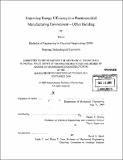| dc.contributor.advisor | Duane S. Boning. | en_US |
| dc.contributor.author | Li, Wu, M. Eng Massachusetts Institute of Technology | en_US |
| dc.contributor.other | Massachusetts Institute of Technology. Dept. of Mechanical Engineering. | en_US |
| dc.date.accessioned | 2010-05-25T21:07:17Z | |
| dc.date.available | 2010-05-25T21:07:17Z | |
| dc.date.copyright | 2009 | en_US |
| dc.date.issued | 2009 | en_US |
| dc.identifier.uri | http://hdl.handle.net/1721.1/55229 | |
| dc.description | Thesis (M. Eng.)--Massachusetts Institute of Technology, Dept. of Mechanical Engineering, 2009. | en_US |
| dc.description | Cataloged from PDF version of thesis. | en_US |
| dc.description | Includes bibliographical references (p. 95-96). | en_US |
| dc.description.abstract | Reducing energy consumption without compromising the quality of products in a pharmaceutical manufacturing environment and maintaining the comfort of employees is of critical important in maintaining the financial viability and competence of the company. Heating, Ventilation and Air Conditioning (HVAC) system was identified as the major energy consumer in both office building and manufacturing building. The step response model of the office indoor temperature to the operating states of the Air Handling Unit (AHU) was developed. Combined with the working schedule of employees, the AHU operation schedule in the office building was modified to accommodate the working schedule of employees while reducing waste. Motion detection lighting control was implemented in the office area to reduce waste by turning off unnecessary lighting automatically. As a result of new AHU operation schedule, AHU motor electricity usage can be reduced by 10,868 kWh/year and chilled water consumption can be reduced by 79,403 kWh/year. Motion detection lighting control could also result in estimated savings of 54,082 kWh/year. | en_US |
| dc.description.statementofresponsibility | by Wu Li. | en_US |
| dc.format.extent | 108 p. | en_US |
| dc.language.iso | eng | en_US |
| dc.publisher | Massachusetts Institute of Technology | en_US |
| dc.rights | M.I.T. theses are protected by
copyright. They may be viewed from this source for any purpose, but
reproduction or distribution in any format is prohibited without written
permission. See provided URL for inquiries about permission. | en_US |
| dc.rights.uri | http://dspace.mit.edu/handle/1721.1/7582 | en_US |
| dc.subject | Mechanical Engineering. | en_US |
| dc.title | Improving energy efficiency in a pharmaceutical manufacturing environment -- office building | en_US |
| dc.type | Thesis | en_US |
| dc.description.degree | M.Eng. | en_US |
| dc.contributor.department | Massachusetts Institute of Technology. Department of Mechanical Engineering | |
| dc.identifier.oclc | 611954606 | en_US |
